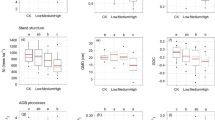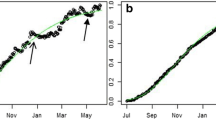Abstract
The stand density of a forest affects the vertical distribution of foliage. Understanding the dynamics of this response is important for the study of crown structure and function, carbon-budget estimation, and forest management. We investigated the effect of tree density on the vertical distribution of foliage, branch, and stem growth, and ratio of biomass increment in aboveground tissues; by monitoring all first-order branches of five trees each from thinned and unthinned control stands of 10-year-old Chamaecyparis obtusa for four consecutive years. In the control stand, the foliage crown shifted upward with height growth but the foliage quantity of the whole crown did not increase. In addition, the vertical distribution of leaf mass shifted from lower-crown skewed to upper-crown skewed. In the thinned stand in contrast, the foliage quantity of individual crowns increased two-fold within 4 years, while the vertical distribution of leaf mass remained lower-crown skewed. The two stands had similar production rates, numbers of first-order branches per unit of tree height, and total lengths of first-order branches. However, the mortality rate of first-order branches and self-pruning within a first-order branch were significantly higher in the control stand than in the thinned stand, which resulted in a higher ratio of biomass increment in branch. Thinning induced a higher ratio of biomass increment in foliage and lower in branch. The increased foliage quantity and variation in ratio of biomass increment after thinning stimulated stem growth of residual trees. These results provide information that will be useful when considering thinning regimes and stand management.







Similar content being viewed by others
References
Antos JA, Parish R, Nigh GD (2010) Effects of neighbours on crown length of Abies lasiocarpa and Picea engelmannii in two old-growth stands in British Columbia. Can J For Res 40:638–647
Bailey RL, Dell TR (1973) Quantifying diameter distributions with the Weibull function. For Sci 19:97–104
Bréda N, Granier A, Aussenac G (1995) Effects of thinning on soil and tree water relations, transpiration and growth in an oak forest (Quercus petraea (Matt.) Liebl.). Tree Physiol 15:295–306
Cannell MGR (1974) Production of branches and foliage by young trees of Pinus contorta and Picea sitchensis: provenance differences and their simulation. J Appl Ecol 11:1091–1115
Chiba Y (1990a) Plant form analysis based on the pipe model theory. I. A statical model within the crown. Ecol Res 5:207–220
Chiba Y (1990b) Plant form analysis based on the pipe model theory. II. Quantitative analysis of ramification in morphology. Ecol Res 6:21–28
Chiba Y, Fujimori T, Kiyono Y (1988) Another interpretation of the profile diagram and its availability with consideration of the growth process of forest trees. J Jpn For Soc 70:245–254
Duursma RA, Mäkelä A, Reid DEB, Jokela EJ, Porté AJ, Roberts SD (2010) Self-shading affects allometric scaling in trees. Funct Ecol 24:723–730
Duursma RA, Falster DS, Valladares F, Sterck FJ, Pearcy RW, Lusk CH, Sendall KM, Nordenstahl M, Houter NC, Atwell BJ, Kelly N, Kelly JWG, Liberloo M, Tissue DT, Medlyn BE, Ellsworth DS (2012) Light interception efficiency explained by two simple variables: a test using a diversity of small- to medium-sized woody plants. New Phytol 193:397–408
Ellsworth DS, Reich PB (1993) Canopy structure and vertical patterns of photosynthesis and related leaf traits in a deciduous forest. Oecologia 96:169–178
Evans GC (1972) The quantitative analysis of plant growth. Blackwell, Oxford
Forrester DI, Medhurst JL, Wood M, Beadle CL, Valencia JC (2010) Growth and physiological responses to silviculture for producing solid-wood products from Eucalyptus plantations: an Australian perspective. For Ecol Manag 259:1819–1835
Garber SM, Maguire DA (2005) The response of vertical foliage distribution to spacing and species composition in mixed conifer stands in central Oregon. For Ecol Manag 211:341–355
Gillespie AR, Allen HL, Vose JM (1994) Amount and vertical distribution of foliage of young loblolly pine trees as affected by canopy position and silvicultural treatment. Can J For Res 24:1337–1344
Han Q (2012) Leaf photosynthetic responses to thinning. In: Najafpour MM (ed) Applied photosynthesis. InTech, Rijeka, pp 215–228
Han Q, Chiba Y (2009) Leaf photosynthetic responses and related nitrogen changes associated with crown reclosure after thinning in a young Chamaecyparis obtusa stand. J For Res 14:349–357
Han Q, Araki M, Chiba Y (2006) Acclimation to irradiance of leaf photosynthesis and associated nitrogen reallocation in photosynthetic apparatus in the year following thinning of a young stand of Chamaecyparis obtusa. Photosynthetica 44:523–529
Hirose T (2005) Development of the Monsi-Saeki theory on canopy structure and function. Ann Bot 95:483–494
Holdaway RJ, Allen RB, Clinton PW, Davis MR, Coomes DA (2008) Intraspecific changes in forest canopy allometries during self-thinning. Funct Ecol 22:460–469
Ilomäki S, Nikinmaa E, Mäkelä A (2003) Crown rise due to competition drives biomass allocation in silver birch. Can J For Res 33:2395–2404
Inoue S, Shirota T, Mitsuda Y, Ishii H, Gyokusen K (2008) Effects of individual size, local competition and canopy closure on the stem volume growth in a monoclonal Japanese cedar (Cryptomeria japonica D. Don) plantation. Ecol Res 23:953–964
Johnsen K, Samuelson L, Teskey R, McNulty S, Fox T (2000) Process models as tools in forestry research and management. For Sci 47:2–8
Kantola A, Mäkelä A (2004) Crown development in Norway spruce [Picea abies (L.) Karst.]. Trees 18:408–421
Kenward MG, Roger JH (1997) Small sample inference for fixed effects from restricted maximum likelihood. Biometrics 53:983–997
Kinerson RS, Higginbotham KO, Chapman RC (1974) The dynamics of foliage distribution within a forest canopy. J Appl Ecol 11:347–353
Lavigne MB (1988) Growth and net assimilation rates in thinned and unthinned stands of balsam fir. Can J For Res 18:1205–1210
Longuetaud F, Seifert T, Leban J-M, Pretzsch H (2008) Analysis of long-term dynamics of crowns of sessile oaks at the stand level by means of spatial statistics. For Ecol Manag 255:2007–2019
Mäkelä A, Valentine HT (2006) Crown ratio influences allometric scaling in trees. Ecology 87:2967–2972
Medhurst JL, Beadle CL (2001) Crown structure and leaf area index development in thinned and unthinned Eucalyptus nitens plantations. Tree Physiol 21:989–999
Medhurst JL, Beadle CL (2005) Photosynthetic capacity and foliar nitrogen distribution in Eucalyptus nitens is altered by high-intensity thinning. Tree Physiol 25:981–991
Mizunaga H, Umeki T (2001) The relationships between tree size and spatial distribution of foliage-mass within crowns of Japanese cedars (Cryptomeria japonica) in young plantations. For Ecol Manag 149:129–140
Mori S, Hagihara A (1991) Crown profile of foliage area characterized with the Weibull distribution in a hinoki (Chamaecyparis obtusa) stand. Trees 5:149–152
Niinimäki S, Tahvonen O, Mäkelä A (2012) Applying a process-based model in Norway spruce management. For Ecol Manag 265:102–115
Noguchi K, Han Q, Araki M, Kawasaki T, Kaneko S, Takahashi M, Chiba Y (2011) Fine-root dynamics in a young hinoki cypress (Chamaecyparis obtusa) stand for 3 years following thinning. J For Res 16:284–291
Osawa A, Ishizuka M, Kanazawa Y (1991) A profile theory of tree growth. For Ecol Manag 41:33–63
Saito S, Sato T, Kominami Y, Nagamatsu D, Kuramoto S, Sakai T, Tabuchi R, Sakai A (2004) Modeling the vertical foliage distribution of an Castanopsis cuspidata (Thunb.) Schottky, a dominant broad-leaved tree in Japanese warm-temperate forest. Trees 18:486–491
Seidel D, Fleck S, Leuschner C, Hammett T (2011a) Review of ground-based methods to measure the distribution of biomass in forest canopies. Ann For Sci 68:225–244
Seidel D, Leuschner C, Müller A, Krause B (2011b) Crown plasticity in mixed forests—quantifying asymmetry as a measure of competition using terrestrial laser scanning. For Ecol Manag 261:2123–2132
Sheriff DW (1996) Responses of carbon gain and growth of Pinus radiata stands to thinning and fertilizing. Tree Physiol 16:527–536
Shinozaki K, Yoda K, Hozumi K, Kira T (1964a) A quantitative analysis of plant form: the pipe model theory. I. Basic analyses. Jpn J Ecol 14:97–105
Shinozaki K, Yoda K, Hozumi K, Kira T (1964b) A quantitative analysis of plant form: the pipe model theory. II. Further evidence of the theory and its application in forest ecology. Jpn J Ecol 14:133–139
Smith DM (1986) The practice of silviculture. Wiley, New York
Tang Z, Chambers JL, Guddanti S, Barnett JP (1999) Thinning, fertilization, and crown position interact to control physiological responses of loblolly pine. Tree Physiol 19:87–94
Turner DP, Acker SA, Means JE, Garman SL (2000) Assessing alternative allometric algorithms for estimating leaf area of Douglas-fir trees and stands. For Ecol Manag 126:61–76
von Oheimb G, Lang AC, Bruelheide H, Forrester DI, Wäsche I, Yu M, Härdtle W (2011) Individual-tree radial growth in a subtropical broad-leaved forest: the role of local neighbourhood competition. For Ecol Manag 261:499–507
Weiskittel AR, Maguire DA, Monserud RA (2007) Response of branch growth and mortality to silvicultural treatments in coastal Douglas-fir plantations: implications for predicting tree growth. For Ecol Manag 251:182–194
Weiskittel AR, Kershaw JA Jr, Hofmeyer PV, Seymour RS (2009) Species differences in total and vertical distribution of branch- and tree-level leaf area for the five primary conifer species in Maine, USA. For Ecol Manag 258:1695–1703
Whitehead D, Edwards WRN, Jarvis PG (1984) Conductig sapwood area, foliage area, and permeability in mature trees of Picea sitchensis and Pinus contorta. Can J For Res 14:940–947
Xu M, Harrington TB (1998) Foliage biomass distribution of loblolly pine as affected by tree dominance, crown size, and stand characteristics. Can J For Res 28:887–892
Zimmermann MH (1983) Xylem structure and the ascent of sap. Springer, New York
Acknowledgments
We thank a number of people from the Laboratory of Plant Production, Forestry and Forest Products Research Institute (FFPRI) who participated in the field measurements. We thank the editor and the two anonymous reviewers for their valuable comments on the earlier version of this paper. All statistics were calculated with SAS/STAT and the assistance of the Computer Center for Agriculture, Forestry and Fisheries Research, MAFFIN, Japan. This research was supported by a grant from the Japanese Ministry of the Environment for Global Environment Research and a research grant from the FFPRI.
Author information
Authors and Affiliations
Corresponding author
About this article
Cite this article
Han, Q., Kabeya, D., Saito, S. et al. Thinning alters crown dynamics and biomass increment within aboveground tissues in young stands of Chamaecyparis obtusa . J For Res 19, 184–193 (2014). https://doi.org/10.1007/s10310-013-0405-2
Received:
Accepted:
Published:
Issue Date:
DOI: https://doi.org/10.1007/s10310-013-0405-2




